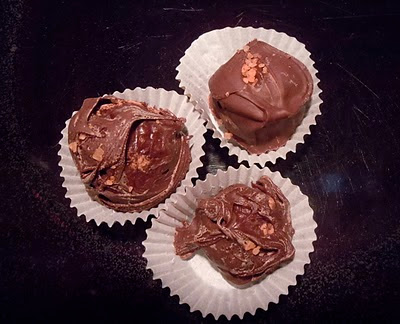My family has been on a quest since before I was born. Simply put: it is the search for the perfect key lime pie. Now, I have no idea how this started. It certainly isn't scientific; there's no spreadsheet anywhere of the various types we've tried or a grading scale of the pies. No, no. It exists more as a philosophical exercise. Think of it like the Platonic Form of the Key Lime Pie. We have a concept of what makes the perfect pie. But it will never exist in reality.
Right, now moving on from that digression into philosophy, I present the nearest approximation we have found to the perfect key lime pie. Well, take away the absolute necessity of the meringue (there are definite views on this in my household), but these have the exact right taste and texture that comprises absolute perfection in terms of key lime-iness. Add the toasted coconut on top. And, well, these don't last long.
They also get points in my book for having not a graham cracker crust (which is typical) but an animal cracker crust. Which my inner child finds vastly amusing. Now, I've never seen animal crackers (read: cookies) in Britain, so this may be yet another typically American food, but it is worth going on the hunt for them. Of course, any sugar cookies (sigh, sorry Britain, biscuits) will do. Hmmm, on second thought, perhaps ginger biscuits or digestives will also do nicely here. Anyway, the point is really in the key limes. And getting fresh ones. The magazine which featured this recipe (Eating Well, Fall 2003) had a whole subsection devoted to how necessary these were to the recipe. Not regular limes. Not even lime juice. But key limes. Well, honestly. If you can't find key limes (and this will inevitably happen), just use regular old limes. Key limes are notoriously difficult to juice and can be difficult to locate. Regular (as they call them, Persian) limes will work and give the bars a bit more of a tart flavor, but will still be delicious. Trust me.
Makes 16 2-inch bars
Ingredients
Crust
5 ounces animal crackers
3 tbsp. packed light or dark brown sugar (I used light)
Pinch table salt
4 tbsp. unsalted butter, melted and cooled slightly
Filling
2 ounces cream cheese, room temperature
2 tbsp. grated key lime zest (or more, I used at least 3 tbsp)
Pinch table salt
1 can (14 ounces) sweetened condensed milk
1 large egg yolk
1/2 cup key lime or regular lime juice
Garnish (optional)
3/4 cup shredded sweetened coconut, toasted until golden and crisp (I use the oven for this. Takes about 5 minutes at 375 degrees).
Method
Adjust oven rack to middle position and heat oven to 325 degrees. Cut about 12-inch length extra-wide heavy foil; fold cut edges back to form 7 1/2 inch width. With folded sides facing down, fit foil securely into bottom and up sides of 8-inch square baking pan, allowing excess to overhang pan sides. Spray foil with non-stick cooking spray.
To make the crust: In bowl of food processor, pulse animal crackers until broken down, about ten 1-second pulses; process crumbs until evenly fine, about 10 seconds (you should have about 1 1/4 cups crumbs). Add brown sugar and salt; process to combine, ten to twelve 1-second pulses (if large sugar lumps remain, break them apart with fingers). Drizzle butter over crumbs and pulse until crumbs are evenly moistened with butter, about ten 1-second pulses.
Press crumbs evenly and firmly into bottom of prepared pan. Bake until deep golden brown, about 18-20 minutes. Cool on wire rack while making filling. Do not turn off oven.
To make the filling: While crust cools, in medium bowl, stir cream cheese, zest, and salt with rubber spatula until softened, creamy, and thoroughly combined. Add sweetened condensed milk and whisk vigorously until incorporated and no lumps of cream cheese remain; whisk in egg yolk. Add lime juice and whisk gently until incorporated (mixture will thicken slightly).
To assemble and bake: Pour filling into crust; spread to corners and smooth surface with rubber spatular. Bake until set and edges begin to pull away slightly from sides, 15-20 minutes (mine took much longer, about 25-30 minutes). Cool on wire rack to room temperature, 1- 1 1/2 hours. Cover wil foil and refrigerate until thoroughly chilled, at least 2 hours.
Loosen edges with paring knife and lift bars from baking pan using foil extensions; cut bars into 16 squares. Sprinkle with toasted coconut, if using and serve.
Note: Leftovers can be refrigerated up to 2 days; crust wil soften slightly. Let bars stand at room temperature about 15 minutes before serving.








